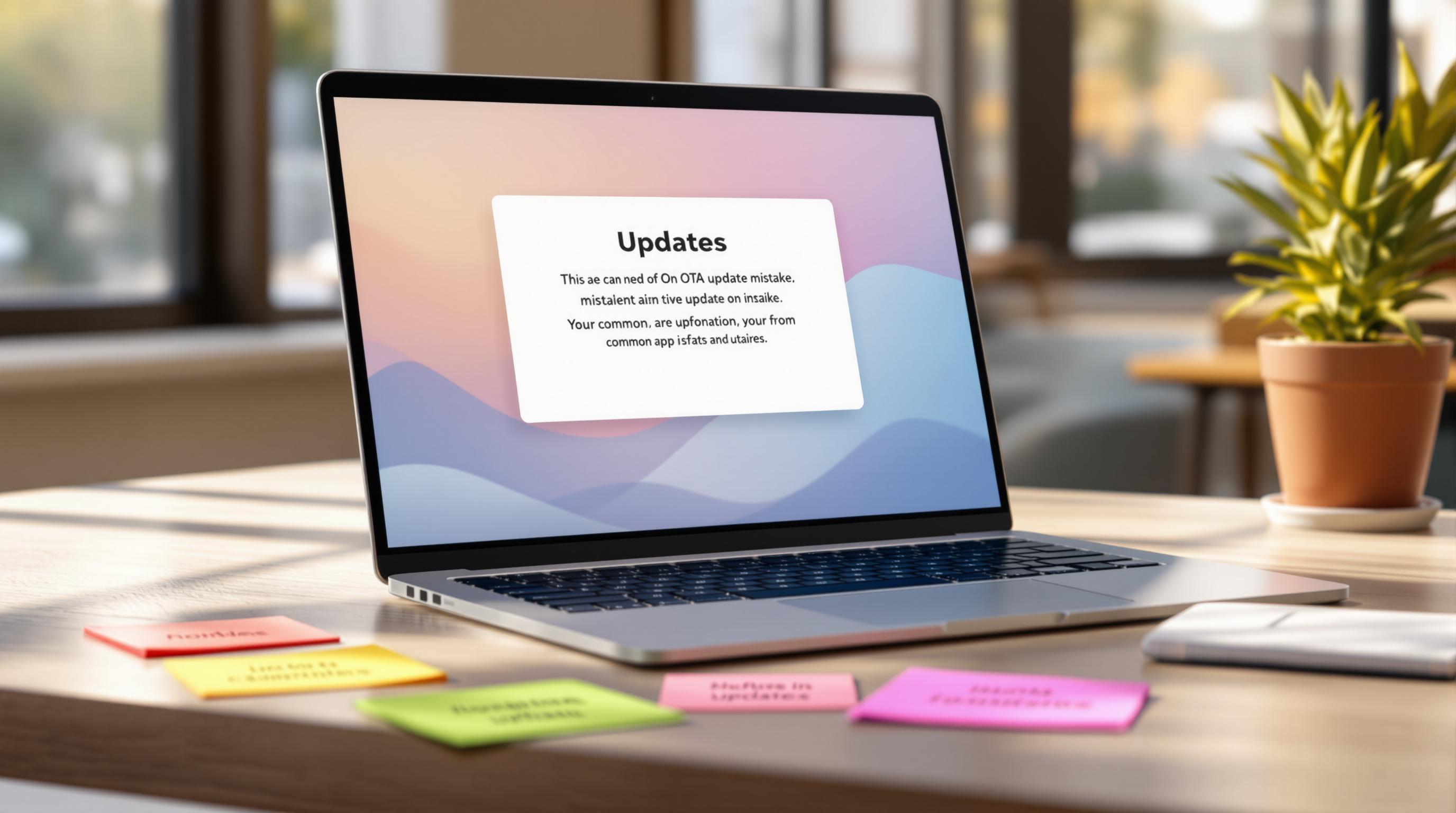Need faster app updates without app store delays? Capgo lets you deliver secure Over-the-Air (OTA) updates instantly to your users. Skip app store reviews and keep your app up-to-date with ease.
Key Takeaways:
- What is Capgo? An open-source platform for live updates in Capacitor apps.
- Why OTA Updates? Save time, improve user experience, and fix bugs quickly.
- How to Get Started?
- Install the Capgo plugin:
npm install @capgo/capacitor-updater - Configure your app with an API key.
- Use channels like “production” or “beta” for targeted rollouts.
- Install the Capgo plugin:
- Advanced Features: End-to-end encryption, error handling, and CI/CD integration.
Capgo’s documentation (capgo.app/docs) provides step-by-step instructions for setup, security, and troubleshooting. From installation to advanced configurations, it’s your go-to guide for seamless updates.
Capgo, CapacitorJs plugin for Live update

Using Capgo Documentation
Navigating documentation effectively is essential when working with OTA updates. Capgo’s documentation offers detailed guidance for integrating live updates into Capacitor apps.
Where to Find the Documentation
You can access Capgo’s documentation at capgo.app/docs [1]. It’s organized into sections based on specific purposes:
| Section | Purpose | Key Topics |
|---|---|---|
| Getting Started | Initial setup | Installation steps, API key setup |
| Configuration | Core settings | Plugin configuration, environment setup |
| API Reference | Technical details | Methods, parameters, return values |
| Security | Protection measures | Encryption setup, signature verification |
| Troubleshooting | Problem-solving | Common issues, diagnostic tools |
Important Terms and Concepts
Here are some key terms you’ll encounter:
- Channels: These are update streams used to control version distribution. For instance, you might set up “production”, “beta”, and “staging” channels to cater to different user groups [4].
- Update Policies: These define how updates are delivered and applied. Options include automatic downloads, installation timing, and user prompts [1].
- App State Listeners: These components track whether the app is in the foreground or background [4].
- Bundles: Packaged update files containing your app’s new version, including assets, code changes, and configuration updates [4].
Code Examples and Tutorials
The documentation provides sample code to simplify integration. Here’s a basic example using TypeScript/JavaScript:
import { CapacitorUpdater } from '@capgo/capacitor-updater'
// Initialize the updaterawait CapacitorUpdater.notifyAppReady()For more advanced use cases, the documentation includes real-world examples [2][3], such as:
- Switching channels for A/B testing
- Custom update flows with user prompts
- Handling errors and implementing rollbacks
- Integrating updates with CI/CD pipelines
Each tutorial also highlights performance considerations and security aspects, helping you make informed decisions. The documentation is frequently updated to include the latest features and best practices [1].
For implementation details, check out the setup guide next.
Setting Up OTA Updates
Set up OTA updates in Capgo to streamline your deployment process. Follow these steps and tips for a hassle-free configuration.
Basic Setup Steps
Start by installing the Capgo plugin in your Capacitor project:
npm install @capgo/capacitor-updaternpx cap syncNext, update your capacitor.config.json file with your Capgo API key:
{ "plugins": { "CapacitorUpdater": { "autoUpdate": true, "apiKey": "YOUR_API_KEY_HERE" } }}Then, initialize the updater in your app’s main file to detect updates:
import { CapacitorUpdater } from '@capgo/capacitor-updater';await CapacitorUpdater.notifyAppReady();Once this is done, you can set up channels to manage different update streams.
Update Channel Setup
Organize your update channels to suit your deployment needs:
| Channel Type | Purpose | Use Case |
|---|---|---|
| Production | Stable releases | General user base |
| Staging | Pre-release testing | QA team and beta testers |
| Beta | Feature testing | Early adopters |
To upload an update to a specific channel, use the Capgo CLI:
npx @capgo/cli upload -c productionUpdate Methods
Capgo provides two main ways to handle updates:
Automatic Updates
Enable automatic updates by setting autoUpdate: true in your configuration. This ensures updates are applied in the background with no extra effort from developers.
Manual Updates
For more control, you can manage updates manually. Use the following pattern to check for and apply updates:
// Check for updatesconst update = await CapacitorUpdater.download();
// Install when readyif (update) { await CapacitorUpdater.set(update);}For critical updates, you can prompt users before proceeding:
if (update.version > currentVersion) { const userConsent = await showUpdatePrompt(); if (userConsent) { await CapacitorUpdater.set(update); }}You can also target specific user groups with custom IDs and channels:
await CapacitorUpdater.setCustomId('beta-tester-123');await CapacitorUpdater.setChannel('beta');Finally, make sure to include error handling and rollback options:
try { await CapacitorUpdater.set(update);} catch (error) { await CapacitorUpdater.reset(); // Revert to the last working version console.error('Update failed:', error);}With these steps, your OTA update system is ready to go. Explore advanced settings to customize the update process further.
sbb-itb-f9944d2
Advanced Settings
Improve your Capgo OTA update setup with added security measures and flexible update configurations. These options ensure a secure and smooth update experience while meeting app store guidelines.
Security Features
Capgo provides strong security protocols to safeguard your update bundles and deliver them securely to users. The platform uses end-to-end encryption with public-key cryptography for all updates [1]. Below is how you can enable key security features:
// Enable bundle verificationawait CapacitorUpdater.setVerifyBundles(true);
// Configure encryption settingsawait CapacitorUpdater.configure({ encryption: { enabled: true, failOnError: true }});Key components of the bundle protection system include:
| Security Feature | Description | Implementation |
|---|---|---|
| Bundle Integrity | Verifies package authenticity with cryptographic signatures | Automatically enabled with setVerifyBundles() |
| Rollback Protection | Reverts to a stable version if an update fails | Built into the update process |
| Access Control | Manages updates with role-based permissions | Configured via the dashboard |
Update Behavior Settings
You can customize how updates are delivered and installed by using event listeners and configuration options. Adjust the timing and user interaction for updates with these settings:
// Listen for when an update is availableCapacitorUpdater.addListener('updateAvailable', async (info) => { if (info.version > currentVersion) { // Custom update logic based on app state const isAppInactive = await checkAppState(); if (isAppInactive) { await CapacitorUpdater.download(); } }});
// Monitor download completionCapacitorUpdater.addListener('downloadComplete', (info) => { console.log(`Update ${info.version} ready to install`); // Implement custom installation timing if desired});For phased rollouts, you can configure update distribution directly through the dashboard or with code:
// Set custom update conditions for a gradual rolloutawait CapacitorUpdater.configure({ rollout: { percentage: 25, // Start with 25% of users timeInterval: 24 // Increase rollout percentage every 24 hours }});To handle specific version-related behaviors:
// Handle version-specific update failuresCapacitorUpdater.addListener('updateFailed', async (info) => { if (info.error.code === 'VERSION_MISMATCH') { await CapacitorUpdater.reset(); // Revert to the last stable version // Optionally, handle error notification here }});These settings ensure updates are reliable while allowing you to tailor the process to your app’s needs. Always test updates thoroughly in Capgo’s staging environment before rolling them out to production [2].
Problem Solving Guide
Capgo’s error logs and built-in tools help tackle OTA update challenges while keeping your app compliant with store requirements.
Common Issues and Solutions
Here are some typical problems and how to address them:
-
Failed Downloads
Symptoms: Downloads freeze or fail to complete.
Solution: Check your network connection, confirm the update URL is valid, and add retry mechanisms to handle interruptions. -
Version Conflicts
Symptoms: Updates either fail to install or cause app instability.
Solution: Use clear version numbers to avoid conflicts and implement rollback options for safety. -
Installation Errors
Symptoms: Updates fail or trigger automatic rollbacks.
Solution: Ensure you callnotifyAppReady()after a successful update to prevent rollbacks.
For updates larger than 50MB, splitting them into smaller files can improve performance on Android devices [5].
Use detailed error logging to catch problems early. For example, implement this listener:
CapacitorUpdater.addListener('updateFailed', (error) => { console.log(`Update failed: ${error.code}`); logUpdateError({ errorCode: error.code, deviceInfo: error.device, timestamp: new Date().toISOString() });});By combining error logging with pre-checks, you can handle these issues effectively before focusing on compliance.
App Store Rules
Technical fixes alone aren’t enough - your updates also need to align with app store guidelines.
Apple App Store Requirements:
- User Transparency: Clearly inform users about the update’s content and get their consent.
- Core Functionality: Ensure your app’s main features remain intact as reviewed.
- Security Measures: Use secure methods for transmitting updates.
Android Implementation:
await CapacitorUpdater.configure({ updateNotification: { title: "Update Available", message: "A new version is available. Please update to access the latest features.", requireUserConsent: true }});Best Practices:
- Version Control: Roll out updates gradually to reduce conflicts.
- Update Notifications: Provide clear and user-friendly update alerts.
- Security: Verify the bundle’s integrity and use encryption to protect data.
Summary
This section pulls together the main ideas from the guide.
Capgo’s documentation provides clear instructions for integrating OTA updates into Capacitor apps while staying compliant with app store regulations.
Using Capgo’s resources, developers can implement essential features like end-to-end encryption and CI/CD integration, covering everything from initial setup to advanced configurations [1].
Key Implementation Areas
| Aspect | Key Focus | Where to Find It |
|---|---|---|
| Security | Encryption and integrity checks | Security Features section |
| Compliance | Meeting Apple and Android requirements | App Store Rules guide |
| Update Management | Version control and rollback options | Update Methods guide |
| Error Handling | Logging and troubleshooting steps | Problem Solving Guide |
These areas form the backbone of Capgo’s update management system.
Capgo’s CLI and analytics tools simplify managing updates throughout your app’s lifecycle [1].
For further support, you can explore additional resources like API documentation, sample projects, and community forums [2].




